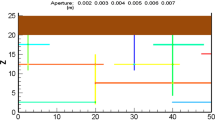Abstract
In this study, we evaluated the conceptualization approaches to represent heterogeneous hydraulic property of a single fracture using geostatistics and stochastic method. Interference tests at the single fracture, which was identified at the depth of about 250 m from the ground surface in the Olkiluoto island, Finland, were simulated. The transmissivity data from the test boreholes were geostatistically analyzed, and the analysis results were used to reproduce the transmissivity field of the single fracture by the ordinary krigging and conditional random generation approaches. The groundwater flow models were calibrated by comparing the observed flow rates at the boreholes during the interference tests to the simulated ones. The simulation results show that the discrepancies between the simulated and observed flow rates became larger as the observed flow rates were large, which indicates that the ordinary krigging and conditional random generation approaches for conceptualization of the single fracture were not be able to sufficiently reflect the real hydraulic property. Nevertheless, the observed flow rates were included in the ranges of simulated ones when using the conditional random generation approach, which shows that the conditional random generation approach is applicable although the number of observations is too small to reenact the real hydraulic property of a single fracture.
Similar content being viewed by others
References
Brush, D.J. and Thomson, N.R., 2003, Fluid flow in synthetic roughwalled fractures: Navier-Stokes, Stokes, and local cubic law simulations. Water Resources Research, 39. doi:10.1029/2002WR001346
Dijk, P.E. and Berkowitz, B., 1999, Three-dimensional flow measurements in rock fractures. Water Resources Research, 35, 3955–3959.
Gershenfeld, N., 1999, The Nature of Mathematical Modeling. Cambridge University Press, Cambridge, 356 p.
Goovaerts, P., 1997, Geostatistics for Natural Resources Evaluation. Oxford University Press, New York, 496 p.
Harbaugh, A.W. and McDonald, M.G., 1996, User’s documentation for MODFLOW-96, an update to the US Geological Survey modular finite-difference ground-water flow model. US Geological Survey Open-File Report 96-485, US Geological Survey, Virginia, 56 p.
International Atomic Energy Agency (IAEA), 2011, Geological disposal facilities for radioactive waste: specific safety guide. IAEA Safety Standards Series, No. SSG-14, IAEA, Vienna, 104 p.
Ji, S.-H., Lee, H.-B., Yeo, I.W., and Lee, K.-K., 2008, Effect of nonlinear flow on DNAPL migration in a rough-walled fracture. Water Resources Research, 44. doi:10.1029/2007WR006712
Konzuk, J.S. and Kueper, B.H., 2004, Evaluation of cubic law based models describing single-phase flow through a rough-walled fracture. Water Resources Research, 40. doi:10.1029/2003WR002356
Nuclear Energy Agency (NEA), 2008, Moving forward with geological disposal of radioactive waste–A collective statement by the NEA radioactive waste management committee (RWMC), NEA No. 6433, OECD, France, 21 p.
Olea, R.A., 1999, Geostatistics for Engineers and Earth Scientists. Kluwer Academic Publishers, Massachusetts, 303 p.
Pekkanen, J., 2009a, Difference flow measurements and hydraulic interference test in ONKALO at Olkiluoto drillholes ONK-PP125, ONKPP127 and ONK-PP129. Posiva Working Report 2009-40, Posiva Oy, Finland, 74 p.
Pekkanen, J., 2009b, Difference flow measurements in ONKALO at Olkiluoto drillholes ONK-PP122–ONK-PP124, ONK-PP126, ONKPP128, ONK-PP131, ONK-PP134 and ONK-PP137. Posiva Working Report 2009-04, Posiva Oy, Finland, 114 p.
Pitkänen, P., Ahokas, H., Ylä-Mella, M., Partamies, S., Snellman, M., and Hellä, P., 2007, Quality review of hydrochemical baseline data from the Olkiluoto site. POSIVA 2007-05, Posiva Oy, Finland, 134 p.
Posiva, 2009, Olkiluoto site description 2008. POSIVA 2009-01. Posiva Oy, Finland, 714 p.
Posiva, 2010, Interim summary report of the safety case 2009. POSIVA 2010-02, Posiva Oy, Finland, 174 p.
Renshaw, C.E. Dadakis, J.S., and Brown, S.R., 2000, Measuring fracture apertures: a comparison of methods. Geophysical Research Letter, 27, 289–292.
Svensk Kärnbränslehantering AB (SKB), 2011, Long-term safety for the final repository for spent nuclear fuel at Forsmark: main report of the SR-Site project. SKB TR-11-01, SKB, Sweden, 893 p.
Zheng, C. and Bennett, G.D., 2002, Applied Contaminant Transport Modeling (2nd edition). John Wiley and Sons, Inc., New York, 621 p.
Author information
Authors and Affiliations
Corresponding author
Rights and permissions
About this article
Cite this article
Ko, NY., Ji, SH., Koh, YK. et al. Hydraulic conceptualization of a single fracture using hydraulic interference tests at a deep underground condition. Geosci J 22, 581–588 (2018). https://doi.org/10.1007/s12303-017-0077-6
Received:
Accepted:
Published:
Issue Date:
DOI: https://doi.org/10.1007/s12303-017-0077-6




